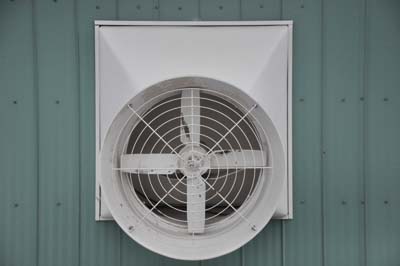
These Are Not Your Father’s Chickens
Jim Knisley
Features New Technology ProductionThe broilers of today produce more heat than they did 20 years ago
When designing a ventilation system for a modern poultry barn, it is vital to remember that these aren’t your father’s chickens.
When designing a ventilation system for a modern poultry barn, it is vital to remember that these aren’t your father’s chickens.
Today’s broilers grow faster and produce 20 per cent more heat than broilers of 20 years ago, said Mike Czarick, an extension engineer at the University of Georgia and an expert in the ventilation of poultry barns.
“The birds have changed, they have higher requirements,” he said at the Poultry Industry Council’s Poultry Innovations Conference, held in Niagara Falls last November.
In summer, meeting these higher requirements requires a ventilation system capable of moving more air. But that doesn’t necessarily mean more fans and expense.
 |
| Fewer, bigger fans. Ventilation expert Mike Czarick says that too many small fans is a poor investment. He advises using fewer, bigger fans. |
He said many barns have too many small fans, which have high operating costs and low efficiency.
“Too many small fans is a very poor investment,” he said.
He advises using fewer and bigger fans. “Using 48-inch fans versus 24-inch fans can cut the initial cost in half,” he said.
In addition, larger fans are twice as energy efficient and that can cut the operating cost in half.
He also suggested placing exhaust fans in groups to minimize cold spots and said that fans do not have to be evenly spaced. While not evenly spacing the fans may seem counterintuitive, “air temperature is not determined by fan placement. It is determined by inlet placement.”
He compared the fans to a bathtub drain that removes air, not water. “Does it matter where the bathtub drain is?” he asked.
Inlet design and placement is more important than fan placement and, in general, an effective system will have lots of inlets and few fans.
The inlets should be designed so they can be adjusted to direct the air. In warm weather – whenever the air outside is warmer than you want it inside – the air should be directed down to cool the birds. In cooler, more moderate weather it should be directed up to mix with warmer air higher in the barn before it drops to bird level. “It is really two inlets in one,” he said.
He also said that circulation fans are a bandage and not a cure for a poor ventilation system. They move a limited amount of air over a limited area. He showed infrared pictures of the effect of a circulation fan. The pictures showed that birds could be standing beside each other and one would be in the area of air movement of the fan and be cool while the adjacent bird would not be in the area affected by the fan and be hot.
Czarick is a proponent of tunnel ventilation. Tunnel ventilation is very effective in warm weather at moving large volumes of air and providing a complete air exchange every 60 seconds.
Even when it is almost calm outside, a tunnel ventilation system will effectively cool a barn.
In cooler weather a tunnel system can be operated like a conventional barn.
In cool or cold weather ensuring the sidewall inlets are properly adjusted is very important to maximize broiler performance and to minimize energy consumption. The sidewall inlets, not fan placement, will determine the air temperature and air quality throughout the barn.
Opening the sidewall inlets too much when it is cold results in too much cold air entering the barn and birds nearest the inlets can get cold. This can lead to poor feed conversion, as those birds eat more to keep warm, and an increase in the use of supplemental heating.
Meanwhile, birds farther from the inlets will face higher temperatures and less fresh air.
To limit bird cooling and spending on fuel, the incoming cold air should be directed along the ceiling where the heat from the birds and heating system collects. This warms the incoming air and helps eliminate cold spots in the barn.
As a take-home message, Czarick said producers should pay particular attention to the inlets, their design and their placement, and try to use fewer and bigger fans.
Print this page